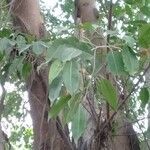Trees, large, deciduous. Bark dark brown. Branchlets pale brown, glabrous. Stipules caducous, broadly lanceolate, 2-4 cm. Petiole slender, 2-4 cm, glabrous or sparsely pubescent; leaf blade elliptic to oblong, 15-20 × 7-9.5 cm, papery, glabrous, base obtuse to rounded, margin entire or slightly undulate, apex abruptly shortly acuminate; secondary veins 9-15 on each side of midvein. Figs axillary on leafy branchlets or on leafless main branches, (1 or) in clusters of 2-8, yellow and white tinged red when mature, 5-8 mm in diam., with conspicuous interfloral bristles; peduncle 5-7 mm; involucral bracts cuplike. Male, gall, and female flowers within same fig. Male flowers: few, near apical pore, sessile; calyx lobes 3 or 4, involute; stamen 1; filament very short. Gall flowers: sessile; calyx lobes 2 or 3; ovary globose to obovate, glabrous; style subapical, short; stigma dilated. Female flowers: calyx lobes 2 or 3; ovary obovate, glabrous; style subapical, long. Achenes flat, smooth. Fl. and fr. Apr-Jul.
A fig. It is a large tree. It loses its leaves during the year. Trees are of one sex. The bark is greyish brown. The branches are pale brown. The leafy growth at the base of the leaf is sword shaped and 2-4 cm long. The leaf stalk is 2-4 cm long and thin. The leaf blade is oblong and 15-20 cm long by 7-9.5 cm wide. The base is rounded and the tip tapers to a short sharp point. There are 9-15 secondary veins each side of the midrib. The figs occur as 2-8 in a group and they are yellow and white when mature. They occur in the axils of leaves or on small branches without leaves. They are 5-8 mm across. The fruit stalk is 5-7 mm long. The male and female flowers occur in the same fig. The male flowers are few and are near the hole.


